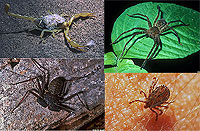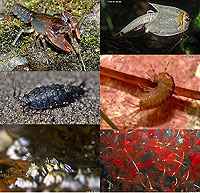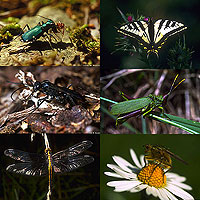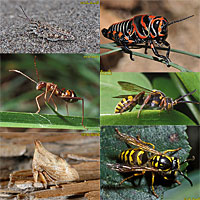Arthropod Characteristics
- Body segmented, with regional specialization (at minimum, head and trunk)
- Hard, chitinous exoskeleton (cuticle) that is molted (ecdysis)
- Pair of jointed appendages on each body segment
- Usually with pair of compound eyes and multiple ocelli (lost in some)
- Reduced coelom forms hemocoel (open circulatory system)
- Well developed digestive, nervous systems
- Extraordinarily diverse: > 1 million species!
|
|
Subphylum Chelicerata
- Body divided into prosoma (fused head and thorax) and opisthosoma (abdomen)
- First pair of appendages modified for feeding: chelicerae
- Appendages biramous
- Lack antennae
- Trilobites may belong in this clade
|
|
Class Merostomata, Order Xiphosurida — Horseshoe Crabs
Characteristics
- Prosoma covered by large, U-shaped carapace
- 5 Pairs of walking legs
- Abdominal appendages flattened into "book gills"
- Long posterior tail (= telson)
- 5 Living species, on ocean bottoms
- Some biologists no longer use Merostomata as this may not be a monophyletic group
|
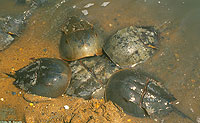
Atlantic Horseshoe Crabs, Limulus polyphemus; mating aggregation; DE
|
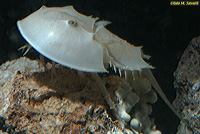
Atlantic Horseshoe Crab, Limulus polyphemus, juvenile
|
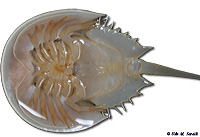
Atlantic Horseshoe Crab, Limulus polyphemus, ventral side
See also labeled photo.
|
|
Order Eurypterida — Sea Scorpions
Characteristics
- Sea Scorpions (extinct)
- One pair of appendages form large, flat paddles
- Prosoma covered in a carapace
- Posterior telson either flattened (for swimming) or stinger-like
- Mostly marine, some in fresh water, and may have been able to briefly move onto land
- Some reached over 2 m long
See additional fossil chelicerates (merostomates) here
|

Sea scorpion models. Models are labeled in large version.
|
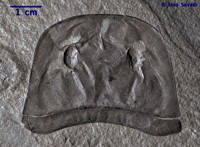
Sea Scorpion, Eurypterus sp., head plate; Silurian Period
|
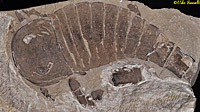
Sea Scorpion fossil, Balteurypterus tetragonophtalmus; Late Silurian Period, Ukraine
|
|
Class Arachnida
Characteristics
- Additional feeding appendages: pedipalps & maxilla
- 4 pairs of walking legs
- Lack abdominal appendages (except for spinnerets in some)
- Nearly all are terrestrial
- Respiration via book lungs or trachea
|
|
|
|
Class Pycnogonida — Sea Spiders
Characteristics
- Small bodies with proportionately long legs (>3x body length)
- Body not differentiated into regions
- Unique proboscis
- Usually 4 pairs of walking legs
- Marine predators on slow-moving or sessile prey
- Larvae are parasitic (mostly on Cnidarians)
|
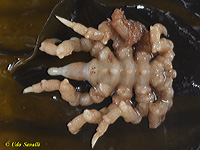
Anemone Sea Spider, Pycnogonum sp. (preserved specimen)
|
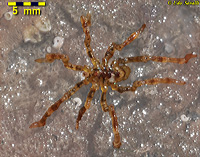
Sea spider, Ammothea hilgendorfi; LaJolla, CA
|
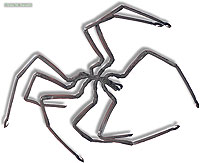
Sea Spider, preserved specimen
See also labeled photo.
|
|
Subphylum Myriopoda
Characteristics
- Body elongated, with multi-segmented trunk
- Little regional differentiation: only cephalon (head) distinct
- Walking legs on nearly all segments
- Antennae present
- Four Classes (Pauropoda not covered here)
|
|
|
Class Diplopoda
- Millipedes
- Pairs of segments fused together
- Appear to have 2 pairs of legs/segment
- Slow moving detritivores
|

North American Millipede, Narceus americanus; NY
|

Polydesmid Millipede, Pachydesmus sp.; KY
|

Sucking Millipede, Siphonophora sp.; Belize
|
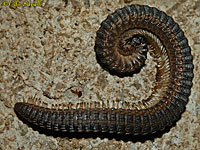
Crested Millipede, Abacion magnum; KY
|
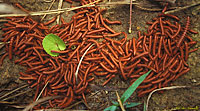
Swarm of Paradoxical Keeled Millipedes (subfamily Paradoxosomatinae; Kenya
|
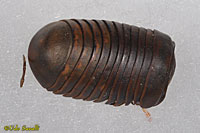
Pill Millipede, dried specimen
|
|
Class Chilopoda
- Centipedes
- Segments not fused; 1 pair of legs/segment
- > 15 pairs of legs
- First pair of legs modified into venomous claws
- Last pair of legs modified into sensory appendage
- Fast moving predators
|
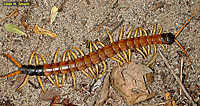
Giant Desert Centipede, Scolopendra heros (Order Scolopendromorpha); Camp Verde, AZ
|
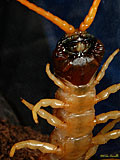
Giant Desert Centipede, Scolopendra heros, ventral view of head
See also labeled photo.
|

Tropical Centipede, Scolopocryptops sp., guarding eggs (Order Scolopendromorpha); CA
|
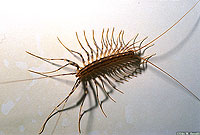
House Centipede, Scutigera coleoptrata (Order Scutigeromorpha); PA
|
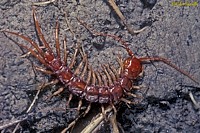
Stone Centipede, Lithobius sp.? (Order Lithobiomorpha); PA
|
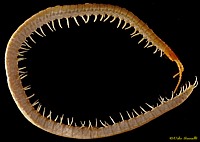
Soil Centipede, (Order Geophilomorpha); preserved specimen
|
|
Class Symphyla
- Garden centipedes or pseudocentipedes
- Small; 12 pairs of legs (fewer in juveniles)
- Lack pigment (white or translucent)
- Lack eyes
- Occur in soils
|

Symphylan (preserved specimen)
|
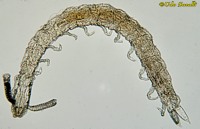
Symphylan (whole mount)
|
|
Subphylum Crustacea
Characteristics
- Head (cephalon) with 5 pairs of appendages; including 2 pairs of antennae
- Trunk usually divided into thorax and abdomen
- Appendages mostly biramous
- Have compound eyes (often on stalks) and ocelli
- Predominantly marine; some fresh water or terrestrial
- Unique nauplius larva
|
|
|
|
Subphylum Hexapoda
Characteristics
- Body with three distinct tagmata: Head (derived from 5 segments); Thorax (3 segments); & Abdomen (11 segments)
- 3 pairs of uniramous legs (on thorax)
- Antennae present
- Trachea for respiration
- Malphigian tubules (excretion)
- Terrestrial (as adults)
|
|
Class Entognatha
Characteristics
- Mouthparts enclosed within head (not externally visible)
- Ametabolous development (no structural differences between juveniles and adults)
- All are wingless
- Eyes reduced or absent
- Most live in soil
|
|
|
Order Collembola
- Springtails
- Furcula: forked jumping appendage at posterior of abdomen
- Small size, <6 mm
|
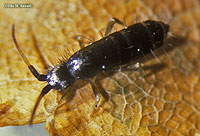
Springtail, Tomocerus nigritus; NY
|
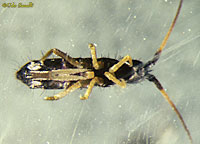
Springtail, Tomocerus nigritus, ventral view showing furculum; NY
|
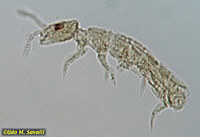
Springtail, whole mount slide
|
|
Orders Protura & Diplura
- Both lack eyes
- Proturans: coneheads
- conical head
- 1st pair of legs held elevated as sensory structure
- Very small, <2 mm
- Diplurans: bristletails & forcepstails
- Pair of posterior appendages (either filamentous or pincer-like)
- Small size, <5 mm
|
|
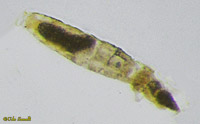
Proturan; whole mount slide
|

Forcepstail (Family Japygidae), AZ; whole mount slide
|
|
Class Insecta
Characteristics
- Insects
- Mouthparts external (usually visible)
- Either hemimetabolous or holometabolous development
- Most have 2 pairs of wings (a few are primitively wingless and some are secondarily wingless)
- Eyes and other sensory structures well developed
- Most diverse class; nearly 1 million species described
|
|
|
|
|






